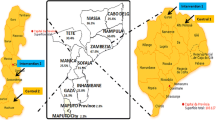ABSTRACT
Insecticide-treated nets (ITNs) reduce malaria transmission and related morbidity and child mortality; however, incorrect and inconsistent use limits their protective factors. This community trial titled the Net Use Intervention study sought to bridge the gap between ITN ownership and use in southern (coastal) Ghana and to determine the best mix of communication tools to affect behavior of ITN owners to consistent use while maintaining optimal internal and external validity. This two-group, non-randomized experiment evaluated a multichannel, multisector intervention process over the course of 8 weeks. A longitudinal cohort was scientifically sampled from six intervention and six control communities for both baseline and posttest surveys. The posttest survey showed no change in knowledge of ITNs in the intervention or control. In terms of use the previous night, there was a strong and statistically significant intervention effect (OR = 1.67; p < .05) within the intervention communities. The overall increase in ITN coverage was approximately one person per night per every two households. The promotion efforts succeeded well beyond the planners’ expectations, not only promoting usage but also dramatically increasing demand for new ITNs.
Similar content being viewed by others
Notes
The full protocol for the formative and qualitative research effort is available from the first author.
Adding the absolute values of the decrease in control households and the increase in the intervention households, and dividing by the number of intervention households ([144 + 131]/519 households), yields a proportion of 0.522.
References
Basch, P. F. (1999). Textbook of international health (2nd ed.). New York: Oxford University Press.
Elder, J. P. (1987). Applications of behavior modification to health promotion in the developing world. Social Science & Medicine, 24, 335–349.
Elder, J. P. (2001). Behavior change & public health in the developing world. Thousand Oaks: Sage Publications.
Graeff, J. A., Elder, J. P., & Booth, E. M. (1993). HealthCom (Program): Communication for health and behavior change: a developing country perspective (1st ed.). San Francisco: Jossey-Bass Publishers.
Kelly, J. A., Lawrence, J. S. S., Diaz, Y. E., et al. (1991). HIV risk behavior reduction following intervention with key opinion leaders of population: an experimental analysis. American Journal of Public Health, 81, 168–171.
United States Agency for International Development (USAID)/Ghana. (2007). Qualitative assessment of the 2007 integrated maternal and child health campaign in Ghana, with a focus on ITN distribution: experiences from four regions of Ghana. Accra: United States Agency for International Development (USAID)/Ghana.
Gimnig, J., Vulule, J., Lo, T., et al. (2003). Impact of permethrin-treated bed nets on entomologic indices in an area of intense year-round malaria transmission. The American Journal of Tropical Medicine and Hygiene, 68, 16–22.
Lindblade, K., Eisele, T., Gimnig, J., et al. (2004). Sustainability of reductions in malaria transmission and infant mortality in western Kenya with use of insecticide-treated bednets: 4 to 6 years of follow-up. Journal of the American Medical Association, 291, 2571–2580.
ter Kuile, F., Terlouw, D., Phillips-Howard, P., et al. (2003). Impact of permethrin-treated bed nets on malaria and all-cause morbidity in young children in an area of intense perennial malaria transmission in western Kenya: cross-sectional survey. The American Journal of Tropical Medicine and Hygiene, 68, 100–107.
Lengeler C. (2004). Insecticide-treated bed nets and curtains for preventing malaria. Cochrane Database of Systematic Reviews, CD000363.
Korenromp, E., Miller, J., Cibulskis, R., et al. (2003). Monitoring mosquito net coverage for malaria control in Africa: possession vs. use by children under 5 years. Tropical Medicine & International Health, 8, 693–703.
Macintyre, K., Keating, J., Okbaldt, Y., et al. (2006). Rolling out insecticide treated nets in Eritrea: examining the determinants of possession and use in malarious zones during the rainy season. Tropical Medicine & International Health, 11, 824–833.
Binka, F., & Adongo, P. (1997). Acceptability and use of insecticide impregnated bednets in northern Ghana. Tropical Medicine & International Health, 2, 499–507.
Cham, M., D’Alessandro, U., Todd, J., et al. (1996). Implementing a nationwide insecticide-impregnated bednet programme in The Gambia. Health Policy Plan, 11, 292–298.
Kachur, S., Phillips-Howard, P., Odhacha, A., et al. (1999). Maintenance and sustained use of insecticide-treated bednets and curtains three years after a controlled trial in western Kenya. Tropical Medicine & International Health, 4, 728–735.
Kroeger, A., Meyer, R., Mancheno, M., Gonzalez, M., & Pesse, K. (1997). Operational aspects of bednet impregnation for community-based malaria control in Nicaragua, Ecuador, Peru and Colombia. Tropical Medicine & International Health, 2, 589–602.
Eisele T., Root B. (2008). Insecticide-treated net use among children and pregnant women in sub-Saharan Africa: systematic review of the evidence. Department of International Health and Development, Tulane University School of Public Health. Prepared for John Hopkins University Center for Communications Programs.
Baume, C. A., & Marin, M. C. (2007). Intra-household mosquito net use in Ethiopia, Ghana, Mali, Nigeria, Senegal, and Zambia: are nets being used? Who in the household uses them? The American Journal of Tropical Medicine and Hygiene, 77(5), 963–971.
Acknowledgements
This effort was funded through an award to the Academy for Educational Development as part of the USAID NetMark Project (HRN-AA-00-99-00016-00) from October 1, 1999 to September 30, 2009. The authors would like to thank Elizabeth (Katie) Guth Bothwell, Dr. Noe Crespo, and Beth Wittry for their assistance with this manuscript.
Author information
Authors and Affiliations
Corresponding author
Additional information
Implications
Practice: Promoting protection from malaria must not only distribute adequate numbers of malaria bed nets but also insure that they are being used as intended with sufficient sustainability to protect a population through at least high-risk seasons.
Policy: Policymakers must support these efforts by insuring that sufficient resources are allotted for communication to target groups including forms of mass as well as interpersonal communication.
Research: It is imperative to continue to validate self-report measures of bed net utilization with some form of visual verification.
About this article
Cite this article
Elder, J.P., Botwe, A.A., Selby, R.A. et al. Community trial of insecticide-treated bed net use promotion in southern Ghana: the Net Use Intervention study. Behav. Med. Pract. Policy Res. 1, 341–349 (2011). https://doi.org/10.1007/s13142-011-0032-4
Published:
Issue Date:
DOI: https://doi.org/10.1007/s13142-011-0032-4




